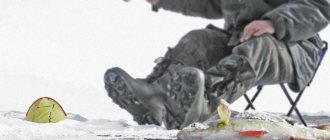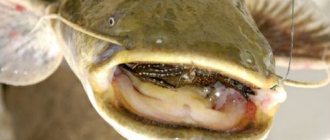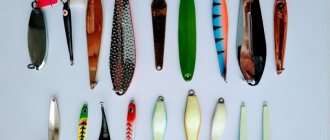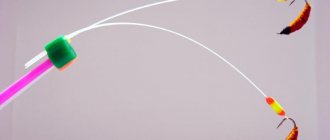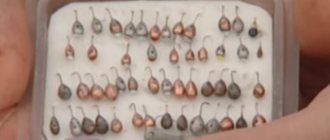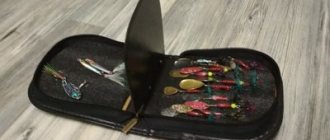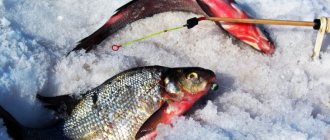Fishing in winter with phosphorus jigs
Before using luminous jigs, the angler must understand some features:
- Bright jigs are not as necessary for our freshwater bodies of water as they are for sea fishing. There are no phosphorescent organisms in our ichthyofauna, so such a bright flashlight under water alarms the fish. But they work, for example, against aggressive pike perch, or in muddy and dirty water.
- Jigs are used that generate a glow of medium or weak strength.
- The market is overflowing with highly luminous plastic jigs. They are lightweight and are used as an additional suspension on garlands and locomotives. We pay more attention to ordinary lead products with fluorescent dots and inclusions - this is a useful thing.
- Jigs with phosphor eyes are used in conditions of poor visibility - primarily at night and in the evening. They can work well at depth or in muddy water, helping the fish determine the point of attack.
- This is just one of the factors that affects the progress of fishing. Such devices can scare away fish, or they can even save fishing. As with any fishing nuances, experimentation is important here. Unpredictable results occur in different fishing conditions.
How to play with a jig when fishing for pike perch
Like catching pike perch with live bait, jig fishing in winter will be more effective when playing slowly without sudden movements. Now it is worth using a uniform and slow game; it is ideal for a passive predator. There is an opinion that a slow jig for catching pike perch is catchy, as it hypnotizes the predator, provoking it to bite.
There are many ways to play, let's talk about one of them:
- We lower the rig to the bottom and take out the slack in the fishing line. It is important to do this carefully, preventing the bait from jerking.
- Raise the jig 5-10 cm above the bottom level and sharply throw it back. We wait about 10 seconds.
- With leisurely movements we raise the bait again, but already 30 cm from the bottom level. To make the game more sweeping, we perform slow swings with the rod.
- We repeat the movements 10 times. If there is no result, then we add holding the jig in the top position.
Slow movements combined with playing with a wide amplitude will most likely lead to a sharp bite. The greatest care should be taken when lowering the bait; it is in this area of movement that bites most often occur.
Originally posted 2018-10-19 13:29:35.
Kinds
Phosphorus (luminous, light-accumulating, fluorescent) baits are divided into three groups, according to the method of application.
Plastic
Such jigs are made from polymers or epoxy resin with the addition of a phosphor. They are light, so they are used as a suspension for heavy bait (higher or lower on the main line), in garlands and locomotives. In such gear they often show themselves in night ice fishing in the current.
Heavy with peephole
Lead or tungsten, of various shapes, attachment or reelless. Phosphorous paint is applied for glow. On sale there are baits that are completely painted with a light-accumulating composition, as well as with a phosphorus head or plate in the front or back. These are the ones that anglers should pay attention to when fishing at night using conventional methods - with a fishing rod or a reelless reel. You can independently apply a drop of phosphorus varnish to the bait, turning it into a light-accumulating one. There are no special tactics to use - we fish the same way as with regular baits, using a riser from the bottom or using a game. The light-accumulating head can be recharged periodically. To do this, you need to bring it to a candle or flashlight.
Hooks with phosphor eyes
In essence, it is just a hook with a drop of fluorescent paint applied to the fore-end. They are used in the same way as the first group. Such hooks work well when fishing for bream at night on descenders and helicopters. You can find them in stores or make them yourself. To do this, a little thread is wound on the forend in the right place (to hold a drop of paint), after which a phosphor is applied.
Homemade jigs for catching pike perch
You can make a jig for pike perch with your own hands quite quickly in winter; there are ways to make the equipment in a matter of minutes. Making your own pike perch jigs is reminiscent of making a spinnerbait, adapted for vertical fishing of a predator.
Several ways to make a jig for pike perch:
- the simplest method of production. We take a small piece of large wire and a cambric made of soft material. We stretch the cambric over the wire to cover part of the hook. It is better to select the diameter of the element such that it is difficult to pull it onto the hook;
- cast a lead jig. Before you make the bait, you need to prepare a mold and place a hook in it or make an eye for a removable hook. Having melted the lead over the stove, pour it into the mold and wait for it to cool. We make a hole in the workpiece. The jig is ready for use;
- We make a copy of the existing jig. We dilute the plaster with water until it is soft, resembling plasticine. Apply oil to the jig and press halfway into the solution. We install a piece of wire in the place where the hole should be. We carry out a similar procedure on the second part of the material - this can be 2 matchboxes. We connect them and make a small hole for pouring metal. After hardening, all that remains is to sand the workpiece.
Read more
Models and characteristics of wobblers "Marauder"
Having a ready-made jig, all that remains is to choose the right way to tie the bait to the fishing line:
- sliding installation. We take a small piece of fishing line and thread it through the hole, and do the same with the second ring. We thread the main fishing line inside the resulting loop. On the opposite side of the fishing line, we make a large knot from the two ends of the segment, which will prevent the jig from slipping;
- leash equipment. We pass the end through the hole, along the hook until the bend begins. We press the fishing line with our finger near the bend and wrap it around the hook with the fishing line. Let go of your finger and thread the fishing line through the resulting loop.
You can make a jig for pike perch with your own hands quite quickly in winter.
Application in fishing
The scope of application of light-accumulating jigs is night and evening fishing. Sometimes they can help out when fishing during the day, in muddy water or at great depths. Fishing tactics depend on the reservoir and the specific type of fish.
For night fishing for bream, roach or crucian carp, standard baits with light-accumulating spots are suitable. When catching various fish in the current, plastic baits (or hooks with drops) are also suitable as equipment for garlands of bluefish, sabrefish, and sopas (white-eye). Such gear works well on reservoirs and large rivers. The use of phosphorus baits when fishing for pike perch brings good results. Even for purely daytime fish, perch, phosphorus provocateurs can work great in the evening or in conditions of poor visibility.
Tactics and techniques for catching pike perch with a jig
All elements of the gear are subject to special requirements in terms of strength, because the fanged one is a strong predator that can damage low-quality gear. Catching pike perch with a jig in winter will be successful if you choose sharp and reliable hooks, because during bites you have to make sharp hooks, otherwise you won’t be able to break through the predator’s mouth. It is better to do the hooking with considerable effort.
Before catching pike perch with a jig in winter, we recommend taking a good nod with you. It's all about the habits of the predator, which, before swallowing prey, tends to touch the bait with the side of its muzzle. Most likely, a bite will follow a few seconds after touching. The nod will help you feel minor vibrations in the water and allow the fisherman to prepare for a sharp hook.
Firefly rig
There is no special equipment for phosphorus baits for winter fishing. Use standard winter fishing gear. A heavy jig with a firefly is simply tied to a fishing line. A light plastic small can be placed higher directly on the main line with a palomar knot or on a leader. It’s exactly the same in locomotives and garlands. The point is not in the equipment itself, but in checking whether such a jig works better than a regular one under given conditions. If yes, then use is justified.
Features of homemade jigs for certain types of fish
In addition to the general operating parameters, jigs have a specific application depending on the type of fish being caught.
When producing baits, you should pay special attention to this nuance, purposefully equipping your fishing arsenal with specific and narrow-profile fishing tools. The distinctive features of narrowly targeted jigs are both the shape preferred by the fish and the promising color
In some cases, weight matters. We will highlight a number of such important features in the further part of our material, taking as an example the most attractive fish species for ice fishing.
Jig for perch
The striped robber is the most common target of ice fishing. Perch prefers jigs in the shape of a droplet, a pellet and any small insect, which is often a type of imitation ant. The optimal size of the simulator should not exceed 4 mm. In relatively calm waters, lead homemade products satisfy this criterion. When fishing rivers with moderate and strong currents, tungsten specimens, which are heavier in mass but identical in size to lead, show the best results. In color schemes, perches prefer dark tones or weights with a shiny surface
Often, the red point of attack in the form of beads, cambric or a piece of thread has a rather serious effect on the number of bites, which is something you should definitely pay attention to when experimenting with the nozzle when the bite is weak and depressive.
Jig for bream
Bream is considered another coveted ice fishing trophy. As a rule, the larger and heavier the bait, the more you can count on catching a larger bream. Bream loves elongated and elongated shapes of jigs.
Breeders will willingly take homemade products in the form of a drop. When hunting bream, you should not additionally load the shank of the hook with beads. Excessive suspicious noise alarms large fish
It is worth paying attention to the colors of bream jigs, which are made in calm natural dark colors. Shiny instruments scare away fish when played
Jig for roach
Roach is also one of the most common fish in winter catches. With proper knowledge of the nuances of the Uralka, made with your own hands and a well-chosen fishing spot, even in the dead of winter, the result is significant in terms of the size of the catch. Roach prefers the shape of jigs in the form of insect larvae, painted black. Ant, banana, classic jig are the most attractive types of imitators. The addition of even artificial bloodworms can greatly increase the number of bites. Do not use large-sized products. The roach is much better detected on miniature, tuned homemade products, matching the sound effects that arise when playing from the contact of beads and a hook. A sharp and distinct game attracts fish, so tungsten jigs modernized with luring elements most clearly correspond to the conditions of ice roach fishing.
Jig for crucian carp
Crucian jigs are similar in shape to roach and perch versions of homemade jigs, the only difference is the size of the hook used. The easiest way to make a product is by soldering it in the form of a spherical shape, a droplet or a bug. The black color is suitable for any fishing conditions, including hunting for crucian carp in open water in the summer. Soldering is done on a hook number 12–14 with an elongated shank and a ring-shaped fastening eye. This size and design for fastening allows you to replant animal bait in the form of a panicle of bloodworms, a pair of maggots or a small dung worm, as well as any artificial imitations of these baits made of silicone and securely attach the bait to the main fishing line. It is worth noting that placing bait on a jig hook when fishing for crucian carp is a key point that contributes to the success of the fish approaching the fishing spot and biting it.
How to make a glowing jig
The Internet is full of information about making plastic jigs for winter fishing from epoxy or hardening polymer compounds. But there is no point in bothering like that. These baits are cheap and there are many of them on sale. It will be more effective to convert the fisherman’s existing baits into phosphorus ones. To do this, you just need to buy a waterproof phosphor varnish and apply a spot on the body of the bait.
According to experienced fishermen, colorful baits burning brightly in the dark do not bring success, but only scare away the fish. A low glow of white or yellowish light works well. The light-accumulating jig should not shine brightly, but only glow faintly. According to some ichthyologists, glow, in principle, rarely attracts freshwater fish; it only provides a sight, a point of attack. From afar, fish are attracted to the bait primarily by the smell of the bait or the vibrations of the water (when fishing for game), and not by the visual characteristics.
Phosphorus jigs with a bright glow work well for sea fish. For example, winter smelt fishing takes place on them.
Subscribe to the channel:
My YouTube channel RYBAFAN on fishing:
We're OK
Tips for choosing a jig for pike perch
The good thing about a jig is that the bait constantly moves in the water with minimal changes in the position of the rod. The bait qualitatively imitates a live fish swimming in a pond. Pike perch does not respond equally well to all jigs; it has its own preferences, which should guide the fisherman in the selection process.
Read more
Lures for catching carp
Bright colors on small jigs are effective in the cold season
What to pay attention to when selecting bait before catching pike perch:
- During the cold season, bright colors on small jigs are effective. In reservoirs with a hungry predator, large white baits are even more effective;
- baitless jigs are only slightly inferior to baited options, but still show good results, save money and time for the fisherman, and also eliminate concerns about the safety of the bait;
- attachment varieties more effectively attract the attention of the fanged. It is more likely that you will be able to attract the attention of a passive predator;
- if the river has a weak current, it is better to take lead models. On rapids, tungsten performs better;
- pike perch more often bites on medium-sized jigs of about 14 mm;
- teardrop-shaped forms have active play;
- the quality of the hooks is one of the main characteristics. It is better to choose models with sharp hooks from well-known manufacturers.
How to make a pike yawn with your own hands
Removing a perch or asp from a hook is not a difficult task, but a pike can easily injure an angler with its sharp teeth. These wounds can be very painful and take a long time to heal, especially if mucus gets into them. A yawner will help you avoid such problems.
Yawner for pike
A yawn is a device made of spring wire that can be used to secure a pike's mouth in an open position. It is usually made from steel wire with a diameter of 3-5 mm.
The yawn must be squeezed in your hand and inserted into the pike’s mouth, and then released. After this, the fish’s jaws are fixed in an open state, and you can easily remove the bait by hand, using an extractor or pliers.
Zevniks are inexpensive and do not take up much space. You can always have one of these devices with you both during boat fishing and when fishing from the shore. Many novice fishermen neglect this accessory and thus significantly complicate their lives. Sometimes the bait can actually be easily removed from the pike's mouth by hand or with pliers, especially in cases where the hook digs into the edge of the jaw.
But often the fish swallows the bait deeply. If this happens, when removing the bait, there is a high risk of cutting your hand on the sharp pike teeth or injuring the trophy, after which it can quickly die. Zevnik eliminates such problems. This device is especially important for spinning anglers who fish using the catch-and-release principle, as it allows them to keep the fish safe and sound.
Designs of yawners
You can find two types of yawners on sale:
- with welded perpendicular jumpers at the ends;
- yawners with balls.
Models of the first type are more convenient to use, as they are most securely fixed in the pike’s mouth. They are equipped with rubber tips that fit onto the bridges, thanks to which the yawner does not injure the pike’s mouth, does not scratch the bag or pocket and the things inside during transportation. But jumpers often break off at welding points, and tips are lost.
Yawners with balls at the ends are easy to transport and break very rarely. But they have a significant drawback - they often turn in the pike’s mouth, so you need to be careful when using them.
Jumpers with jumpers are equipped with a special wire bracket, with which they can be held in the folded state during transportation. In the case of models with balls, this is not necessary - one end of the gapper simply winds behind the other.
Do it yourself
We'll look at how to make a pike yawn with your own hands in this section. A yawn can be made from a bicycle spoke. You can also use a piece of flat steel wire of a suitable diameter.
- You need to take a knitting needle or wire and, using pliers, make one and a half turns in the middle; you can use a screwdriver handle, a file handle, or another suitable object as a shape.
- The ends of the shed must be bent at right angles so that they look in different directions, then they must be processed with a file, removing the burrs.
- After this, you need to put rubber tubes on the ends of the wire so that the fisher does not injure the fish and does not scratch the bag or pocket and the things in them during transportation.
You can also make a wire brace that fits over the yawner to keep it folded when not in use. Thanks to this clip, the device will be more convenient to carry and transport.
A yawner cannot be called a mandatory device, but fishing with it is much more convenient. Many beginning spinning players do not pay attention to this issue, but this is wrong. Every pike hunter should have a yawner in his arsenal. This device is inexpensive, and you can easily make it yourself. It does not take up much space, and you can always have it on hand when fishing. Using a yawner, it is easy to remove the bait from the pike’s mouth, while the likelihood of injury or damage to the fish’s mouth is minimized.
